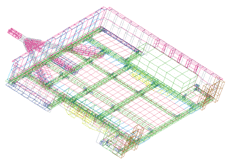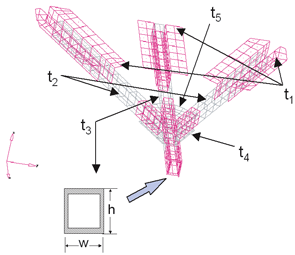Latest News
January 1, 2005
By Louise Elliott
Around 15 years ago, the Ford Motor Company asked Dr. Kyung K. Choi,now a Carver professor at the University of Iowa, to develop a methodto optimize vehicle design with the objective of reducing weight forfuel economy, while improving the vehicle noise-vibration-harshness(NVH) performance measures.
Choi realized the objective by optimizing the thickness of the platesused in the car body. A typical vehicle may have 150 panels, he says.Which should be thick? Which thin? How would such changes affect noisein the car? He knew that design sensitivity studies gave preciseinformation about noise inside the car. Those studies identified panelthicknesses appropriate to reducing noise at such points as thedriver’s and passengers’ ears, and his optimized design was based onthose studies.
When used with an integratedapproach, flexible-body motion models like this MSC.ADAMS model allow maximumdynamic loading conditions, leading to moreaccurate durability assessments.
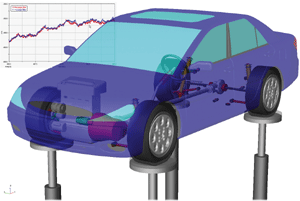
However, although the optimized car bodies proved highly effective, thecompany found that six prototype cars cost $1 million—even though theironly significant difference from existing production models was thepanel thicknesses. “This occurred,” says Choi, “because to get theoptimized thicknesses precisely without any variability (uncertainty),the panels had to be placed in acid baths. Naturally, this is verycostly and would not be used for a production line. Even with a massproduction process, the lowest price they could charge buyers would be$100,000 - which no one would pay for such small changes. The problemwas that no room had been left for variability in manufacturing andmaterials processes.”
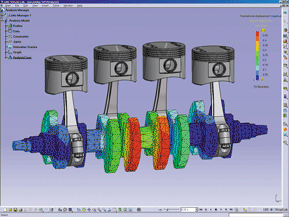 |
When used with an integrated approach, flexible-body motionmodels like this MSC.ADAMS model allow maximumdynamicloading conditions, leading to more accurate durability assessments. |
Sensitivity to Reliability
An ability to account for variability mathematically plays a role inimproved mechanical reliability as well. Today’s automotivemanufacturers have learned that the issues important to durability(fatigue) analyses and reliability are more important to customers, andthus to their bottom lines, than optimization for a single performancemeasure. Variability issues present the main problems when dealing withreliability, and the lessons learned by Choi about the importance ofsensitivity studies play a part in the broadened, more affordableanalyses he now performs.
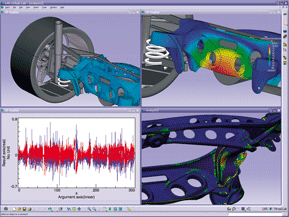 |
Modal participation factors for deformation and stresses are displayedin function of time. While postprocessing the durability results, suchas fatigue damage or hot spots, LMS Virtual.Lab Durabilityautomatically locates major fatigue damage. |
The length of time it takes to run these studies affects their use, andwhile techniques to determine fatigue life factors exist in finiteelement analysis (FEA) systems, using only FEA for reliability testsalong with various probabilistic methods can take too long, even withtoday’s powerful, fast computers. So high-end motion simulationmodels—based on both rigid and flexible bodies—are now used inconjunction with FEA and probabilistic techniques, because the modelshave just a tiny fraction of the degrees of freedom of FEA models, andconsequently require just a fraction of the computations.
|
Engineers working on an Army trailer designed in Pro/E put together an integratedmultibody,flexible body motion simulation model by applying FEA-supplieddeflection, displacement, and vibration results to a rigid-body model. |
Both LMS CAE with its Virtual.Lab Motion and MSC.Software’s SimOfficeincluding MSC.ADAMS, MSC.Nastran, MSC.Dytran, and MSC.Robust Designsystems are deeply involved in working with the automotive industry toprovide ways to build durability and reliability into car and truckdesign. Choi is currently working with the U.S. Army’s Tank-AutomotiveResearch, Development and Engineering Center (TARDEC), and ArmyMateriel Systems Analysis Activity (AMSAA) to develop air-transportablecombat vehicles, and has chosen to work with LMS to commercialize hisapproaches.
Dick Kading, market manager for Multi-body Simulation for LMS CAE,says, “FEA stress (deflection and displacement) and vibration resultsdefine how the parts in a multibody structure perform and form thebasis for flexible-body dynamics models. Built-in procedures in suchFEA programs as Nastran, ANSYS, and Abaqus make it easy to bring insuch information, which can then be animated to see flexibledeformations. This approach provides accurate forces for bothdurability and reliability analyses.”
|
Nastran, Ansys, and Abaqus make it easy to automate informationtransfer. The motion model speeds up fatigue analysis, which wasmeasured by applying time history loads to the flexible-body motionmodel already containing the FE results. |
Although such analyses are fundamentally nonlinear in nature,superimposing small linear effects on a rigid body provides sufficientinformation for the flexible-body simulation. “Some criticalapplications may require nonlinear FEA, but for most applications,flexible-body motion gives a good approximation of deformations underload and take much less time to perform,” Kading says.
To transform the resulting data into durability or fatigue results,engineers apply time history loads to the FE profile embodied by theflexible-body model and can determine how long it will take for theparts to fail. “Traditionally, analysts used measured loads with stressresults to predict fatigue life, but they can actually improve theirresults by taking the time history of the flexible bodies.”
Christoph Ortmann, MSC.Software business development director for theglobal automotive industry, agrees that flexible-body motion modelsgenerate the most accurate loads as input for fatigue analysis, andadds that “an integrated approach makes it possible to move towardmaximum dynamic loading conditions for more accurate durabilityassessment as opposed to static loading conditions.”
Differing Sensitivity Studies Under WaySuch optimization will be based on reliability, and that has to accountfor variability. The two companies part company on exact approaches.LMS plans to use an approach pioneered by Choi that uses analyticalsensitivity studies to determine reliability. MSC.Software usessensitivity studies for running two different kinds of probabilisticstudies.Both approaches use Design of Experiments (DOE), defined as astructured, organized method for determining the relationship betweenfactors affecting a process and the output of that process.
DOE factors can also define sensitivity studies and their application.“Users can construct a response surface for DOE and change the variousfactors to see which have the greatest effect on critical performanceparameters,” Ortmann says. “Users of MSC.Software can performsensitivity sweeps in this way, and reduce the number of factors frommore than 50 to four or five. They can then zero-in on reliability byusing MSC.Robust Design’s stochastic approach, or response surfacemethods.”
|
Design optimization and reliability analysis forfatigue life was carried out using design variables shown in thisillustration. The “t” is thickness of the hollow rectangular bar(gray cross section) or the attachment angles. |
Ortmann adds that these techniques make it possible to studyreliability along with such shape optimization issues as adding holesand taking away weight, or analyzing the number of spot welds neededfor a car body. He points out that such reliability offers economicvalue for the automotive industry. “It shows them where they have tokeep manufacturing tolerances tight, and where they can loosen them up,and of course it lowers warranty costs down the line. Interest in thesetools is growing in this industry, especially now that computation timecan be reduced with powerful computers and distributed computing.Automotive designers and analysts always have to answer the question ofwhether a particular kind of analysis fits into their developmentwindow.”
Choi’s approach involves analytically calculating reliability directlyfrom sensitivity data. This requires running many simulations andsubjecting their derivatives (sensitive study results) to rigorousmathematical analysis.
A major point of this approach is to reduce the objective of thereliability-based design optimization (RBDO) problem that has to bestudied. “If someone sets a target number for a given performancerequirement—such as internal noise in a car—and analyzes how manyvehicles meet it, he’s quantifying reliability,” Choi says. However,the objective is to meet both the target number and reliability for agiven performance measure.
“For example, suppose it’s been decided that the maximum noise levelhas to be 45 decibels. Engineers analyzing the cars may find that only70 percent actually meet that noise level requirement due tovariability of the manufacturing and materials processes. How can theyimprove upon that?”
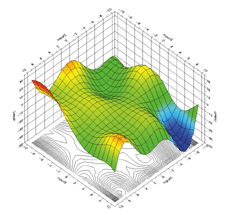
Based on the results of this set of virtual experiments, OPTIMUS fromNOESIS Solutions, an LMS subsidiary, is able to use interpolationmethods to create so-called Response Surface Models that allowextremely quick evaluation and visualization of the design space.
Choi suggests a more effective method: “We want to know how much thecriteria need to be changed to achieve 95 percent reliability. If theanalysis finds that at 45 decibels 30 percent fail, but at 50 decibelsonly 5 percent fail—the problem itself changes. Now the questionbecomes how to reduce the decibel level from 50 to 45.” This is calledthe Performance Measure Approach and it is very well received by theexperts in the research community. Choi is currently using thesemethods to help TARDEC and AMSAA.
Ortmann says automotive OEMs like General Motors’ Opel subsidiary,Audi, and Ford as well as Tier 1 suppliers like Magna are using methodsincluding those mentioned here. Kading points to experience withflexible-body simulations used by BMW, DaimlerChrysler, GM, and othersas a starting point for durability analysis.
Choi’s work for the U.S. Army may point the way again. “Unlike thecommercial automotive industry, which makes changes in increments, theArmy wants to build something they never had before.” Toward that goal,he is working on the suspension to reduce the weight throughreliability studies that incorporate fatigue life—a far cry fromoptimizing designs so much that they cost too much to market.
Contributing editor Louise Elliott is a freelance writer based inCalifornia. Offer Louise your feedback on this article through[email protected]
Virtual.Lab Motion
LMS International
Leuven, Belgium
lmsintl.com
SimOffice
MSC.Software
Santa Ana, CA
mscsoftware.com
Subscribe to our FREE magazine, FREE email newsletters or both!
Latest News
About the Author
DE’s editors contribute news and new product announcements to Digital Engineering.
Press releases may be sent to them via [email protected].







